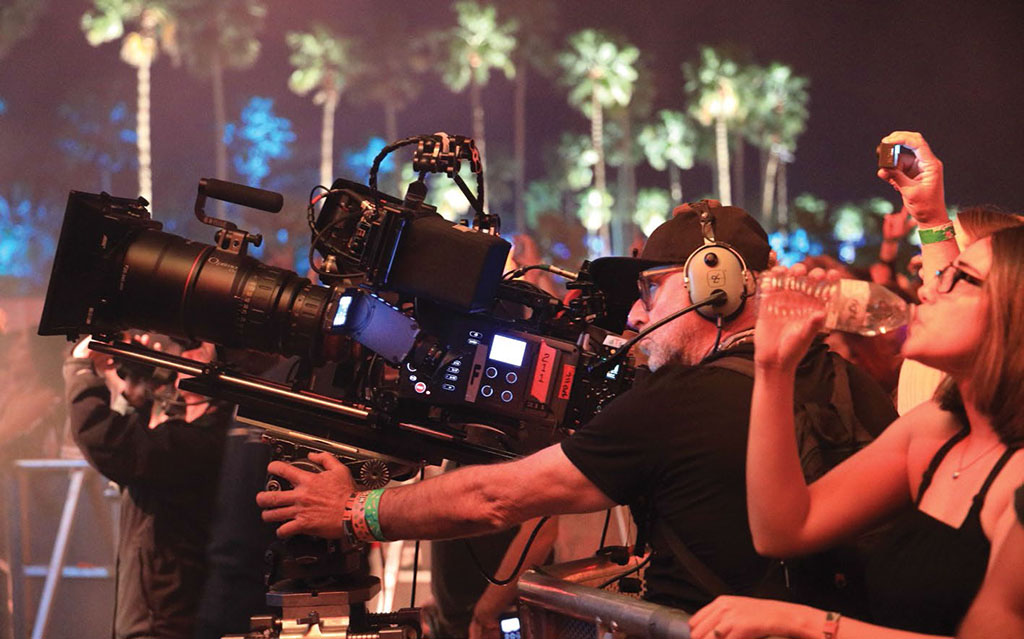ARRI Setup Brings Cinematic Look to Coachella Festival

LOS ANGELES—After working with music concert and festival company Goldenvoice and the Coachella organizers for years, we wanted to do something special for this year’s Coachella music festival in Palm Springs, Calif. I’ve always felt that the way traditional broadcasters capture and live stream music festivals is flat—they use the same camera and equipment to capture a music festival as they would a baseball or football game. But music needs more artistic elements as well as more style and more of a cinematic feel.
That’s what led me to propose a new approach to Coachella this year: Take over one of the stages, shoot it with cinema cameras, lenses and DPs, and livestream to YouTube. Our goal was to improve the look, feel and style of the live stream and give the audience a stream that’s more representative of live music.
Goldenvoice allowed me to take over the outdoor stage and work with the Springboard broadcast company to give the show a whole new feeling. We wanted to improve the artistic expression and feel of the shots, to bring back that cinematic element to the live cast. To achieve this, one of the most dramatic changes we made was to replace traditional broadcast cameras with true cinema cameras from ARRI.
BROADCASTING CINEMA QUALITY
For me, the ARRI look is more representative of film and the great concert films of the past that were captured on film, including the dynamic range, highlight control and the deep blacks. We used a combination of the ARRI AMIRAs and the ALEXA Mini in a multicamera format.
We used the ALEXA Mini on a Technocrane and the AMIRAs for our fixed camera positions as well as with our handheld camera operators. For the handhelds, we incorporated wireless video to transmit the signal, allowing the camera operators to be mobile and not tethered to a cable.
The AMIRAs operated in multicam mode. With a DTS fiber chain, we converted the SDI signals to fiber, brought them back into the broadcast truck and streamed to YouTube live, a remarkable achievement. Even though we were shooting in a film style with DPs, cinema lenses and ARRIs, we were able to incorporate it back into the same traditional broadcast fiber system. So, the AMIRAs with the DTS System worked flawlessly.
It was a real game‐changer and an eye‐opener for the broadcast crew who have never seen anything like this. Because the technology now exists, we can keep moving forward with this live cinema approach.
NIGHT AND DAY
The change of look was definitely noticed by everyone, including spectators. Our stage definitely garnered the most positive reviews and comments. If you looked at the broadcast feed side by side with our feed with the ARRI cameras, it was night and day. It just looked beautiful, especially in daytime exteriors with high contrast situations. I held the highlights and also held the bottom end and the shadow detail with the increased dynamic range.
It just crushed the broadcast cameras so even to the untrained eye it just looked better. To the trained eye, it was a remarkable difference—it looked like you were watching a movie or a Drake concert film or music video live.
It was so remarkable that we were asked to do this again with the ARRI cameras next year on the two biggest stages at Coachella. I’m really looking forward to upping the game for live music broadcast with the ARRI Multicam System.
Kenny Stoff is a director and DP with nearly 20 years of experience shooting live music, concerts, documentaries and more. Based on his experience and feedback at Coachella, Kenny has started a new high‐end multi‐cam production company, wide+close. Contact Kenny Stoff atkennystoff.com.
For more information, please visitarri.com.
Get the TV Tech Newsletter
The professional video industry's #1 source for news, trends and product and tech information. Sign up below.
